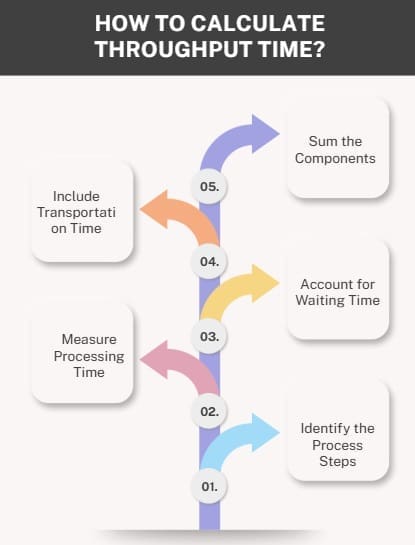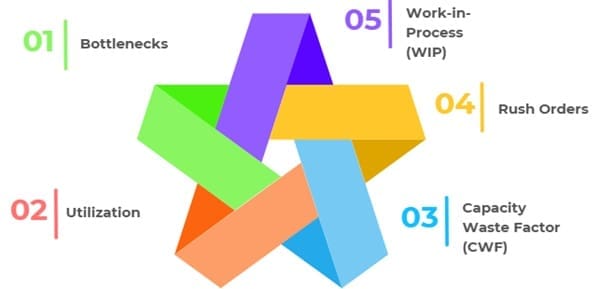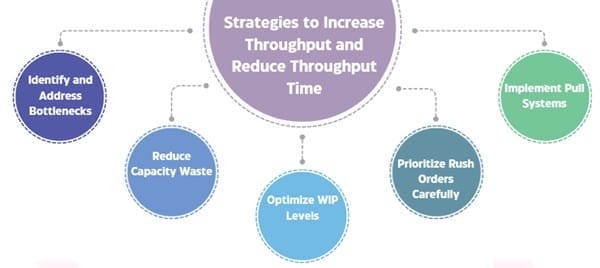Throughput time is the total time it takes for a product, service, or process unit (known as a flow unit) to move through an entire system, from the moment it enters until it exits as a finished output. It includes all stages: processing time, waiting time in queues, and transportation time between workstations.
In manufacturing, throughput time in manufacturing reflects the efficiency of the production process, highlighting bottlenecks and delays. For example, if a widget takes 5 minutes to process, waits 10 minutes in a queue, and spends 2 minutes in transport, the throughput time is 17 minutes. It’s a key metric for optimizing operations and ensuring timely delivery.
Table of contents
What is Throughput Time?
Throughput time refers to the total time it takes for a product, service, or process unit (known as a flow unit) to move through an entire system—from the moment it enters the process until it exits as a finished output.
Unlike other metrics like cycle time, which focuses on the time a resource takes to complete one unit, throughput time encompasses all stages, including processing, waiting, and transportation times. In essence, it’s a comprehensive measure of how long a flow unit resides in the system as work-in-process (WIP).
To put it simply, throughput time answers the question: How long does it take to get from point A to point Z in a production process? It’s a vital metric for understanding process efficiency, identifying bottlenecks, and ensuring timely delivery to customers.
Throughput Time vs. Cycle Time: What’s the Difference?
A common point of confusion is the difference between throughput time and cycle time. While both are time-based metrics, they serve distinct purposes:
- Cycle Time: The time a resource or machine takes to complete one unit of work. It’s an internal measure of a resource’s capability, calculated as the inverse of the resource’s capacity (Cycle Time = 1/Capacity).
- Throughput Time: The total time a flow unit spends in the system, including processing, waiting in queues, and transportation. It’s a broader measure that reflects external demand and system performance.
For example, if a machine processes one widget every 5 minutes (cycle time), but the widget waits in a queue for 10 minutes before and after processing, the throughput time would be significantly longer than the cycle time.
Public, Onsite, Virtual, and Online Six Sigma Certification Training!
- We are accredited by the IASSC.
- Live Public Training at 52 Sites.
- Live Virtual Training.
- Onsite Training (at your organization).
- Interactive Online (self-paced) training,
Why it matters in Manufacturing?
In manufacturing, throughput in manufacturing is a cornerstone of operational success. High throughput time can indicate inefficiencies, such as bottlenecks, excessive waiting periods, or resource underutilization. By contrast, minimizing throughput time can lead to faster delivery, reduced inventory costs, and improved customer satisfaction. Here’s why it matters:
- Customer Satisfaction: Shorter throughput times mean faster delivery, which is critical in industries where customers expect quick turnaround.
- Cost Efficiency: Reducing throughput time decreases the amount of work-in-process inventory, lowering holding costs and freeing up capital.
- Competitive Advantage: Companies with optimized throughput times can outpace competitors by delivering products more quickly and reliably.
- Bottleneck Identification: Analyzing throughput time helps pinpoint bottlenecks—resources with the lowest capacity that slow down the entire process.
By focusing on throughput metrics, businesses can align their operations with demand, streamline processes, and boost profitability.
Also Read: Turnaround Time
How to Calculate Throughput Time?

Calculating throughput time involves summing up all the time components a flow unit experiences in a system. The throughput time formula can be expressed as:
Throughput Time = Processing Time + Waiting Time + Transportation Time
Here’s a step-by-step guide to calculate throughput:
- Identify the Process Steps: Map out the entire process, from raw material input to finished product output. Include every activity, queue, and transportation step.
- Measure Processing Time: Determine the time each resource takes to process one flow unit (this is often the unit load or work content).
- Account for Waiting Time: Include time spent in queues or buffers due to bottlenecks or resource unavailability.
- Include Transportation Time: Factor in the time it takes to move flow units between workstations.
- Sum the Components: Add all these times to get the total throughput time.
Example Calculation
Imagine a manufacturing process with four sequential activities:
- Mailroom Clerk: 1 minute per unit
- Data Entry Clerk: 5 minutes per unit
- Claims Processor: 8 minutes per unit
- Claims Supervisor: 2.5 minutes per unit
If there’s no waiting or transportation time, the theoretical throughput time is:
1 + 5 + 8 + 2.5 = 16.5 minutes
However, in reality, waiting times due to bottlenecks or high utilization can increase this significantly. If the process has a bottleneck (e.g., the mailroom clerk with a capacity of 1 unit per minute) and waiting times add 10 minutes, the actual throughput time becomes:
16.5 + 10 = 26.5 minutes
Also Read: Time Study Analysis
Throughput Rate and Its Relationship to Throughput Time
The throughput rate is the number of flow units processed per unit of time (e.g., units per hour). It’s closely related to throughput time because it reflects how quickly the system can produce output. The throughput rate formula is:
Throughput Rate (R) = Number of Flow Units / Time
In a synchronized system, throughput rate equals demand (R = D). The inverse of the throughput rate gives the takt time, which is the time available to produce one unit to meet demand:
Takt Time = 1 / Throughput Rate
For example, if demand is 12 units per hour, the throughput rate is 12 units/hour, and the takt time is:
1 / 12 = 5 minutes per unit
Takt time ensures that production pace aligns with customer demand, while throughput time measures the actual time a unit spends in the system.
Factors Affecting Throughput Time

Several factors influence throughput time, and understanding them is key to optimization:
- Bottlenecks: The resource with the lowest capacity (the bottleneck) dictates the system’s throughput rate. For example, if the mailroom clerk can only process 1 unit per minute, the entire process is limited to that rate.
- Utilization: High utilization (close to 100%) can lead to congestion, increasing waiting times and throughput time. Lower utilization (e.g., 50%) allows smoother flow but may indicate underused resources.
- Capacity Waste Factor (CWF): Distractions like maintenance, setups, or rework increase the effective unit load, reducing capacity and extending throughput time.
- Rush Orders: Prioritizing rush orders can delay standard orders, increasing their throughput time, as discussed in research by Trzyna et al. (2012).
- Work-in-Process (WIP): Higher WIP levels can lead to longer queuing times, as explained by Little’s Law (Throughput Rate × Flow Time = Inventory).
By addressing these factors, businesses can reduce throughput time and improve efficiency.
Strategies to Increase Throughput and Reduce Throughput Time

To achieve higher throughput and lower throughput time, consider these strategies:
- Identify and Address Bottlenecks: Cross-train employees or add resources to the bottleneck station. For example, training a claims supervisor to assist the mailroom clerk can increase capacity.
- Reduce Capacity Waste: Minimize distractions like maintenance or rework by implementing lean practices or predictive maintenance.
- Optimize WIP Levels: Use pull systems to control WIP, ensuring that throughput time doesn’t balloon due to excessive inventory.
- Prioritize Rush Orders Carefully: Limit the share of rush orders to avoid delaying standard orders. Research suggests a critical rush order share of 10-30% to maintain logistical performance.
- Implement Pull Systems: Unlike push systems, which release work based on forecasts, pull systems control WIP to align production with actual demand, reducing throughput time.
Little’s Law: The Connection Between Throughput, WIP, and Flow Time
Little’s Law provides a fundamental relationship in operations management:
Throughput Rate (R) × Flow Time (T) = Inventory (I)
This equation links throughput rate, throughput time (or flow time), and work-in-process inventory. For example, if a system processes 3.6 units per day with a throughput time of 10.67 hours, the average inventory is:
I = 3.6 × (10.67 / 8) ≈ 4.8 units
By reducing throughput time or controlling WIP, businesses can optimize inventory levels and improve cash flow.
Applications
Throughput time analysis is critical across industries:
- Manufacturing: Reducing throughput time in automotive or electronics manufacturing speeds up delivery and reduces costs.
- Healthcare: In hospitals, minimizing throughput time for patient processing improves care delivery and resource utilization.
- Service Industries: Law firms or insurance companies use throughput time to streamline document processing, as seen in the example of a law firm handling contracts.
By measuring and optimizing throughput time, businesses can enhance operational efficiency and customer satisfaction.
FAQs About Throughput Time
What is throughput time in manufacturing?
Throughput time in manufacturing is the total time a product takes to move through the production process, from raw material to finished goods, including processing, waiting, and transportation times.
How is throughput time different from cycle time?
Throughput time measures the entire time a unit spends in the system, while cycle time is the time a resource takes to process one unit. Throughput time includes waiting and transportation, but cycle time does not.
How do you calculate throughput time?
Throughput time is calculated by summing processing time, waiting time, and transportation time for a flow unit as it moves through the system.
What factors affect throughput time?
Bottlenecks, high utilization, capacity waste, rush orders, and excessive work-in-process inventory can increase throughput time.
How can businesses reduce throughput time?
Businesses can reduce throughput time by addressing bottlenecks, minimizing capacity waste, controlling WIP, and carefully managing rush orders.
Final Words
Throughput time is more than just a metric—it’s a window into the efficiency of your operations. By understanding what throughput time is, how to calculate it, and how to optimize it, businesses can unlock significant improvements in productivity, cost savings, and customer satisfaction. Whether you’re managing a manufacturing line, a service process, or a healthcare system, mastering throughput time is key to staying competitive.



















